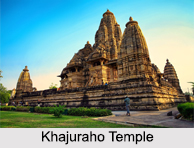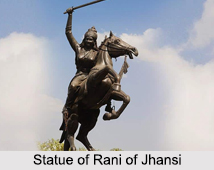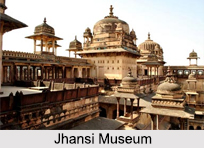 Bundelkhand is an important cultural region and mountain range in India. This hilly area is divided between two states- Uttar Pradesh and Madhya Pradesh. But most of the portion of this region falls on the Madhya Pradesh state. Jhansi is the major city of Bundelkhand, which is an important hub of culture, education, transport and economy. After this, some other major cities of this region are Konch, Kalpi, Chirgaon, Datia, Dabra, Mauranipur, Panna, Banda, Chitrakoot, Tikamgarh, Rath, Lalitpur, Sagar, Damoh, Jalaun, Orai, Hamirpur, Mahoba, Banda, Ashoknagar, and Chhatarpur. Khajuraho is one of the most popular places of Bundelkhand. It is a group of Hindu and Jain temples situated in Chhatarpur, Madhya Pradesh. This UNESCO World Heritage Site is adorned with 10th century sculptures, which are dedicated to fine living and eroticism. Kalinjar, a fortress city, is another popular place of Bundelkhand region.
Bundelkhand is an important cultural region and mountain range in India. This hilly area is divided between two states- Uttar Pradesh and Madhya Pradesh. But most of the portion of this region falls on the Madhya Pradesh state. Jhansi is the major city of Bundelkhand, which is an important hub of culture, education, transport and economy. After this, some other major cities of this region are Konch, Kalpi, Chirgaon, Datia, Dabra, Mauranipur, Panna, Banda, Chitrakoot, Tikamgarh, Rath, Lalitpur, Sagar, Damoh, Jalaun, Orai, Hamirpur, Mahoba, Banda, Ashoknagar, and Chhatarpur. Khajuraho is one of the most popular places of Bundelkhand. It is a group of Hindu and Jain temples situated in Chhatarpur, Madhya Pradesh. This UNESCO World Heritage Site is adorned with 10th century sculptures, which are dedicated to fine living and eroticism. Kalinjar, a fortress city, is another popular place of Bundelkhand region.
Etymology of Bundelkhand
Bundelkhand means "Bundela domain". The region was earlier known as Jejabhukti or Jejakabhukti. According to the inscriptions of the Chandela dynasty, this name was derived from Jeja, the nickname of their ruler Jayashakti. However, it is believed that this name has been derived from an even earlier name of the region: "Jajhauti" or "Jijhoti". After the Bundelas replaced the Chandelas around 14th century, the region came to be known as Bundelkhand after them.
 History of Bundelkhand
History of Bundelkhand
The Bundelkhand region has considerable historical significance. The Chandela Rajput clan ruled Bundelkhand from the 10th to the 16th centuries. One of the notable rulers, Vidyadhar (1017-29) expanded the kingdom of Chandella dynasty to its supreme extent, extending the Chandela dominions to the Chambal River in the northwest and south to the Narmada River. The Chandelas built the famous temple-city of Khajuraho between the mid-10th and mid-11th centuries.
During the Chandela period, Bundelkhand became a flourishing Jain community and numerous Jain temples were constructed in that period. In the 12th century, the Rajput Chauhan monarchs of Ajmer challenged the Chandelas. The Muslim conquests of the early 13th century curtailed the Chandela domains, although they survived until the 16th century as minor chieftains.
The Khangar ruled the areas of present-day Bundelkhand after the fall of the Chandelas. The capital of Khangar kingdom is Garh Kundar. Their seat of power was at Garh Kundar, a fort built by the grandson of Maharaja Khet Singh Khangar, the founder of Khangar Kingdom. During the Khangar dynasty rule, Bundelkhand was known as Jujhauti, implying the land of warriors. Bundela later succeeded the Khangar Rajputs in the mid 14th century by capturing Khangar Kingdom capital Garh Kundar, then moved it to Orchha. Later, the region came under the rule of Mughal Empire from 16th to 18th century. Akbar`s governors at Kalpi maintained a nominal authority over the surrounding district, and the Bundela chiefs were in a state of unending revolt, which culminated in the war of independence under Chhatrasal.
In 1671, Chhatrasal raised the banner of revolt against the Mughals in Bundelkhand at the age of 22, with an army of 5 horsemen and 25 swordsmen on Chhatrapati Shivaji`s advice. During the first ten years of his revolt, he conquered the whole of Bundelkhand. After the death of Chhatrasal in 1731, most of the conquered parts of the Marathas were bequeathed to the tributary local rulers. During 18th century, Bundelkhand was freed from the Maratha power to some extent.
The parts ceded by Marathas were later called British Bundelkhand by the Treaty of Bassein in 1802. Peshwa in Pune had to give up all of their rights over Bundelkhand to the British after the 1817 Anglo-Maratha War. In 1811, Bundelkhand Agency was formed. In 1853, after the death of the Raja of Jhansi, his territory was annexed to the British Bundelkhand. His wife, Rani Laxmi Bai protested against this annexation because his adopted son was not recognized as an heir to his adoptive father. After the Revolt of 1857, Jhansi was given to the Maharaja of Gwalior, but later it came under the British in 1886, when it was swapped for Gwalior Fort. In 1871, Bangelkhand Agency was formed by detaching the eastern portion of the Bundelkhand Agency. But deforestation and famine were accelerating on a high level during British rule, as a result of which, population of the Bungelkhand Agency came to 13% between 1891 and 1901. To recover the situation, Bungelkhand was merged into the Bundelkhand Agency in 1931.
 After Indian independence in 1947, the princely states of Bundelkhand Agency were combined with those of the former Bagelkhand Agency to form the province of Vindhya Pradesh, which became an Indian state in 1950. On 1st November 1956, Vindhya Pradesh was merged into Madhya Pradesh.
After Indian independence in 1947, the princely states of Bundelkhand Agency were combined with those of the former Bagelkhand Agency to form the province of Vindhya Pradesh, which became an Indian state in 1950. On 1st November 1956, Vindhya Pradesh was merged into Madhya Pradesh.
Geography of Bundelkhand
Bundelkhand lies on the Indo-Gangetic Plain bordering the states of Uttar Pradesh and Madhya Pradesh. It is a gently sloping upland with barren hilly terrain having sparse vegetation. The region is traversed by three mountain ranges, the Vindhya Mountain Range, Fauna and Bander chains beyond which there are isolated hills. The main rivers are the Sindh River, Betwa River, Ken River, Bagahin River, Tons River, Pahuj River, Dhasan River and Chambal River. There are also many artificial lakes. The Kali Sindh River, rising in Malwa, marks the western edge of Bundelkhand.
Bundelkhand State Movement
After Indian independence in 1947, the princely states of Bundelkhand were combined with those of the former Bagelkhand Agency to form the province of Vindhya Pradesh, which became an Indian state in 1950. On November 1, 1956, Vindhya Pradesh was merged into Madhya Pradesh.
Since the early 1960s there has been a movement for establishing a Bundelkhand state or promoting development of the region. In spite of being rich in minerals, the people of Bundelkhand are very poor and the region is underdeveloped and underrepresented in state and central politics. The agrarian crisis and farmers` suicides are also cited as reasons for separate statehood.
Culture of Bundelkhand
Bundeli language has certain similarities with Hindi language. It is predominantly Hindu. However, Jainism is historically significant in Bundelkhand, and several Tirthas are located in this region. Some of the folk dances of Bundelkhand are Badhai, Rai, Saira, Jawara, Akhada, Shaitan, Dhimrai etc.
Tourism in Bundelkhand
Bundelkhand's most renowned place is Khajuraho which has a number of 10th century temples. The mines of Panna are famous for magnificent diamonds. Bundelkhandi is the most common Hindi dialect spoken in the area. The region is predominantly Hindu, but there are also a number of Jain Tirthas. The region is a fraction of the Narmada River Valley dry deciduous forests eco region. The original vegetation consisted of tropical dry forest. The Panna Tiger Reserve (Panna National Park) in Panna and Chhatarpur districts boasts of tigers and a variety of other wildlife.



















